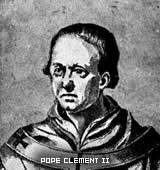 After Henry III had disposed of Gregory VI (and Sylvester III and Benedict IX)
the way was open for a new election. When the Romans meekly told Henry to select
the new pope, he chose Adalbert, archbishop of Hamburg.
After Henry III had disposed of Gregory VI (and Sylvester III and Benedict IX)
the way was open for a new election. When the Romans meekly told Henry to select
the new pope, he chose Adalbert, archbishop of Hamburg.
Adalbert definitely refused, but he suggested a substitute, Suidger, bishop of
Bamberg. Suidger was not particularly anxious to exchange his beloved Bamberg
for turbulent Rome; but Henry liked the idea and persuaded Suidger to accept. He
was enthroned as Clement II. Suidger was born in Saxony of noble parents.
He entered the ecclesiastical state and became chaplain of Herman, archbishop of
Hamburg, canon of Halberstadt, and finally in 1040, bishop of Bamberg. He was a
holy man and a kind one. On Christmas Day 1046, Clement was enthroned.
Immediately after the ceremony the new pope crowned Henry and his wife Agnes.
Henry not only became emperor but assumed the title of Patrician, and to him the
Romans conceded the right of nominating the pope. So general was the disgust at
the irresponsible conduct of the Roman nobility that this act, which tended to
place the papacy in thraldom to the Emperor, was actually hailed with joy even
by reformers. And indeed as long as Henry III lived it worked well enough. But
the danger is that not every emperor is a Henry III. Clement II wasted no time
in starting his reform campaign.
Early in January 1047 he held a synod in Rome which condemned simony and
punished those guilty of this sin by excommunication. Indeed, anyone who
knowingly even accepted ordination at the hands of a simoniacal bishop was
condemned to do penance for forty days. Clement sought the advice of the great
St. Peter Damian. This monk, whose outspokenness in denouncing abuses would make
a modern gasp, did much to help Clement. Clement accompanied Emperor Henry III
in a progress through Southern Italy.
At the Emperor's wish, the Pope excommunicated the people of Benevento when they
refused to open their gates to the imperial party. Clement then accompanied
Henry at least to Northern Italy. At Pesaro he was struck down by illness and on
October 9, 1047, Clement II died. There was suspicion that ex-Pope Benedict IX
had poisoned him, but this suspicion does not seem to be justified.
Clement was an able and holy pope, but his pontificate had been too brief to
allow him to do more than make a good start toward reform. He granted a number
of privileges especially, of course, one to his beloved see of Bamberg.
Excerpted from "Popes
Through the Ages" by Joseph Brusher, S.J.

